University Building Physics ENGT 5146: Sunlight & Overheating Report
VerifiedAdded on 2023/01/03
|28
|7410
|97
Report
AI Summary
This report, titled "Assignment B: Design to Maximize the Benefits of Sunlight and Avoid Overheating," examines solar gains in a proposed building to determine passive design features and strategies for improved thermal performance and reduced energy consumption. The building's total gains exceeded the recommended value, indicating a potential for overheating, especially during summer. The report details various heat gain sources, including solar radiation, equipment, and occupants, and explores heat transfer mechanisms like conduction, convection, and radiation. The analysis includes calculations of internal casual gains, solar gains, and total gains for different building orientations and locations, as well as average daylight factors. The report recommends passive design strategies such as heavyweight construction, optimal building location, layout, orientation, window sizing and placement, and external shading to maximize winter solar gains and minimize summer overheating, thereby reducing heating and cooling demands and enhancing overall thermal performance. The average daylight factors were found to be adequate, but artificial lighting may be needed at times. The report concludes with recommendations for maximizing the benefits of sunlight while minimizing overheating risks, providing a comprehensive overview of building physics principles and practical applications.
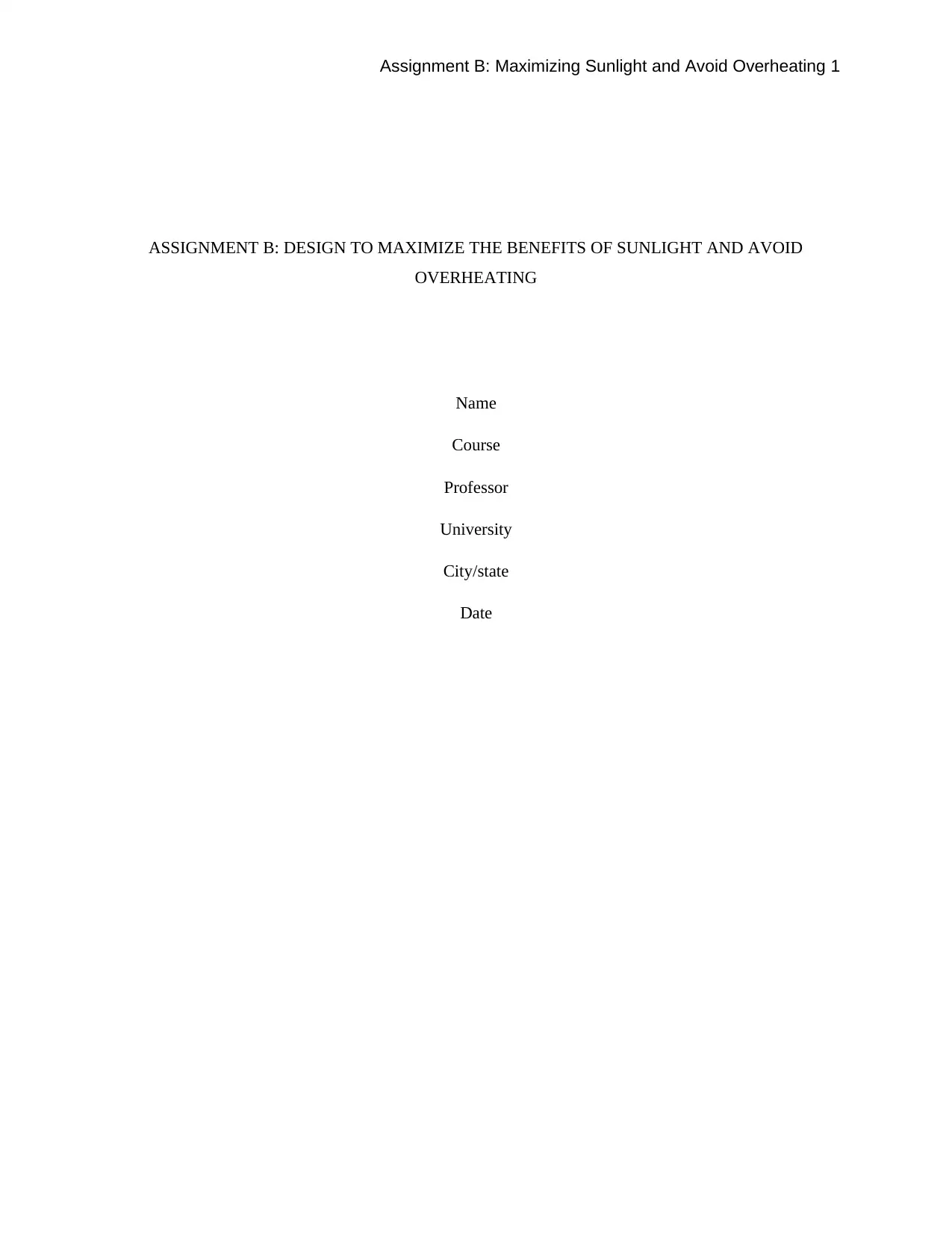
Assignment B: Maximizing Sunlight and Avoid Overheating 1
ASSIGNMENT B: DESIGN TO MAXIMIZE THE BENEFITS OF SUNLIGHT AND AVOID
OVERHEATING
Name
Course
Professor
University
City/state
Date
ASSIGNMENT B: DESIGN TO MAXIMIZE THE BENEFITS OF SUNLIGHT AND AVOID
OVERHEATING
Name
Course
Professor
University
City/state
Date
Paraphrase This Document
Need a fresh take? Get an instant paraphrase of this document with our AI Paraphraser
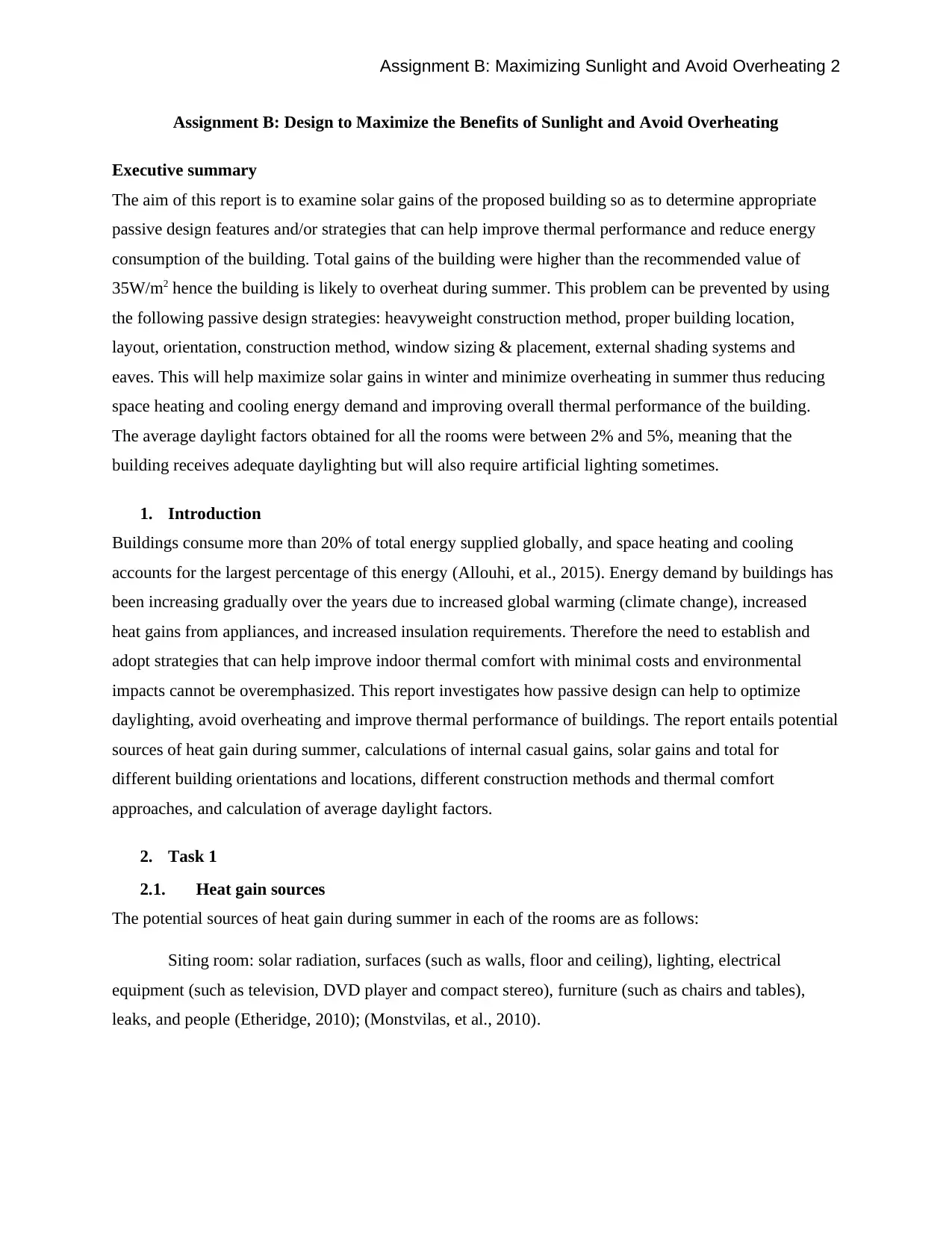
Assignment B: Maximizing Sunlight and Avoid Overheating 2
Assignment B: Design to Maximize the Benefits of Sunlight and Avoid Overheating
Executive summary
The aim of this report is to examine solar gains of the proposed building so as to determine appropriate
passive design features and/or strategies that can help improve thermal performance and reduce energy
consumption of the building. Total gains of the building were higher than the recommended value of
35W/m2 hence the building is likely to overheat during summer. This problem can be prevented by using
the following passive design strategies: heavyweight construction method, proper building location,
layout, orientation, construction method, window sizing & placement, external shading systems and
eaves. This will help maximize solar gains in winter and minimize overheating in summer thus reducing
space heating and cooling energy demand and improving overall thermal performance of the building.
The average daylight factors obtained for all the rooms were between 2% and 5%, meaning that the
building receives adequate daylighting but will also require artificial lighting sometimes.
1. Introduction
Buildings consume more than 20% of total energy supplied globally, and space heating and cooling
accounts for the largest percentage of this energy (Allouhi, et al., 2015). Energy demand by buildings has
been increasing gradually over the years due to increased global warming (climate change), increased
heat gains from appliances, and increased insulation requirements. Therefore the need to establish and
adopt strategies that can help improve indoor thermal comfort with minimal costs and environmental
impacts cannot be overemphasized. This report investigates how passive design can help to optimize
daylighting, avoid overheating and improve thermal performance of buildings. The report entails potential
sources of heat gain during summer, calculations of internal casual gains, solar gains and total for
different building orientations and locations, different construction methods and thermal comfort
approaches, and calculation of average daylight factors.
2. Task 1
2.1. Heat gain sources
The potential sources of heat gain during summer in each of the rooms are as follows:
Siting room: solar radiation, surfaces (such as walls, floor and ceiling), lighting, electrical
equipment (such as television, DVD player and compact stereo), furniture (such as chairs and tables),
leaks, and people (Etheridge, 2010); (Monstvilas, et al., 2010).
Assignment B: Design to Maximize the Benefits of Sunlight and Avoid Overheating
Executive summary
The aim of this report is to examine solar gains of the proposed building so as to determine appropriate
passive design features and/or strategies that can help improve thermal performance and reduce energy
consumption of the building. Total gains of the building were higher than the recommended value of
35W/m2 hence the building is likely to overheat during summer. This problem can be prevented by using
the following passive design strategies: heavyweight construction method, proper building location,
layout, orientation, construction method, window sizing & placement, external shading systems and
eaves. This will help maximize solar gains in winter and minimize overheating in summer thus reducing
space heating and cooling energy demand and improving overall thermal performance of the building.
The average daylight factors obtained for all the rooms were between 2% and 5%, meaning that the
building receives adequate daylighting but will also require artificial lighting sometimes.
1. Introduction
Buildings consume more than 20% of total energy supplied globally, and space heating and cooling
accounts for the largest percentage of this energy (Allouhi, et al., 2015). Energy demand by buildings has
been increasing gradually over the years due to increased global warming (climate change), increased
heat gains from appliances, and increased insulation requirements. Therefore the need to establish and
adopt strategies that can help improve indoor thermal comfort with minimal costs and environmental
impacts cannot be overemphasized. This report investigates how passive design can help to optimize
daylighting, avoid overheating and improve thermal performance of buildings. The report entails potential
sources of heat gain during summer, calculations of internal casual gains, solar gains and total for
different building orientations and locations, different construction methods and thermal comfort
approaches, and calculation of average daylight factors.
2. Task 1
2.1. Heat gain sources
The potential sources of heat gain during summer in each of the rooms are as follows:
Siting room: solar radiation, surfaces (such as walls, floor and ceiling), lighting, electrical
equipment (such as television, DVD player and compact stereo), furniture (such as chairs and tables),
leaks, and people (Etheridge, 2010); (Monstvilas, et al., 2010).
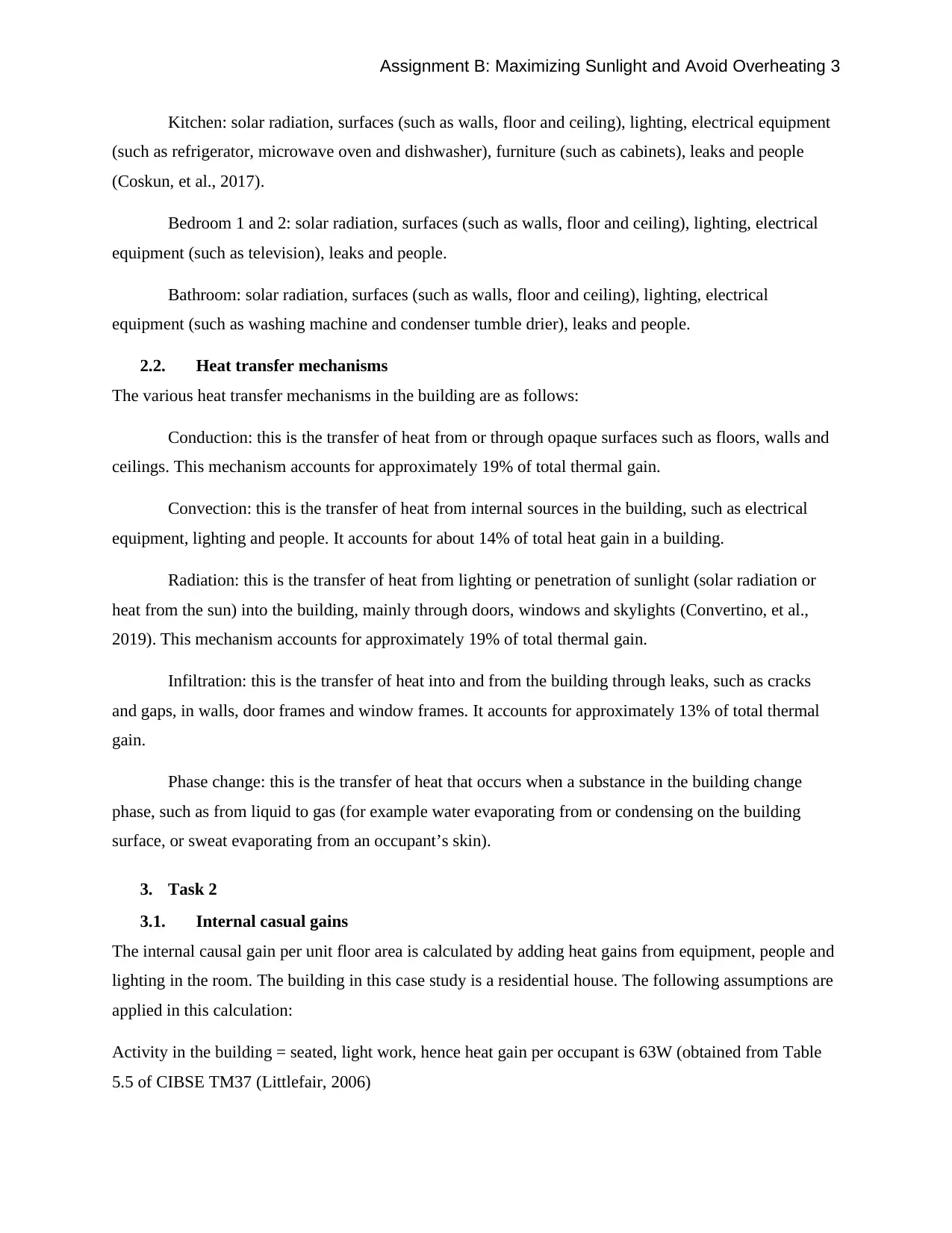
Assignment B: Maximizing Sunlight and Avoid Overheating 3
Kitchen: solar radiation, surfaces (such as walls, floor and ceiling), lighting, electrical equipment
(such as refrigerator, microwave oven and dishwasher), furniture (such as cabinets), leaks and people
(Coskun, et al., 2017).
Bedroom 1 and 2: solar radiation, surfaces (such as walls, floor and ceiling), lighting, electrical
equipment (such as television), leaks and people.
Bathroom: solar radiation, surfaces (such as walls, floor and ceiling), lighting, electrical
equipment (such as washing machine and condenser tumble drier), leaks and people.
2.2. Heat transfer mechanisms
The various heat transfer mechanisms in the building are as follows:
Conduction: this is the transfer of heat from or through opaque surfaces such as floors, walls and
ceilings. This mechanism accounts for approximately 19% of total thermal gain.
Convection: this is the transfer of heat from internal sources in the building, such as electrical
equipment, lighting and people. It accounts for about 14% of total heat gain in a building.
Radiation: this is the transfer of heat from lighting or penetration of sunlight (solar radiation or
heat from the sun) into the building, mainly through doors, windows and skylights (Convertino, et al.,
2019). This mechanism accounts for approximately 19% of total thermal gain.
Infiltration: this is the transfer of heat into and from the building through leaks, such as cracks
and gaps, in walls, door frames and window frames. It accounts for approximately 13% of total thermal
gain.
Phase change: this is the transfer of heat that occurs when a substance in the building change
phase, such as from liquid to gas (for example water evaporating from or condensing on the building
surface, or sweat evaporating from an occupant’s skin).
3. Task 2
3.1. Internal casual gains
The internal causal gain per unit floor area is calculated by adding heat gains from equipment, people and
lighting in the room. The building in this case study is a residential house. The following assumptions are
applied in this calculation:
Activity in the building = seated, light work, hence heat gain per occupant is 63W (obtained from Table
5.5 of CIBSE TM37 (Littlefair, 2006)
Kitchen: solar radiation, surfaces (such as walls, floor and ceiling), lighting, electrical equipment
(such as refrigerator, microwave oven and dishwasher), furniture (such as cabinets), leaks and people
(Coskun, et al., 2017).
Bedroom 1 and 2: solar radiation, surfaces (such as walls, floor and ceiling), lighting, electrical
equipment (such as television), leaks and people.
Bathroom: solar radiation, surfaces (such as walls, floor and ceiling), lighting, electrical
equipment (such as washing machine and condenser tumble drier), leaks and people.
2.2. Heat transfer mechanisms
The various heat transfer mechanisms in the building are as follows:
Conduction: this is the transfer of heat from or through opaque surfaces such as floors, walls and
ceilings. This mechanism accounts for approximately 19% of total thermal gain.
Convection: this is the transfer of heat from internal sources in the building, such as electrical
equipment, lighting and people. It accounts for about 14% of total heat gain in a building.
Radiation: this is the transfer of heat from lighting or penetration of sunlight (solar radiation or
heat from the sun) into the building, mainly through doors, windows and skylights (Convertino, et al.,
2019). This mechanism accounts for approximately 19% of total thermal gain.
Infiltration: this is the transfer of heat into and from the building through leaks, such as cracks
and gaps, in walls, door frames and window frames. It accounts for approximately 13% of total thermal
gain.
Phase change: this is the transfer of heat that occurs when a substance in the building change
phase, such as from liquid to gas (for example water evaporating from or condensing on the building
surface, or sweat evaporating from an occupant’s skin).
3. Task 2
3.1. Internal casual gains
The internal causal gain per unit floor area is calculated by adding heat gains from equipment, people and
lighting in the room. The building in this case study is a residential house. The following assumptions are
applied in this calculation:
Activity in the building = seated, light work, hence heat gain per occupant is 63W (obtained from Table
5.5 of CIBSE TM37 (Littlefair, 2006)
⊘ This is a preview!⊘
Do you want full access?
Subscribe today to unlock all pages.

Trusted by 1+ million students worldwide
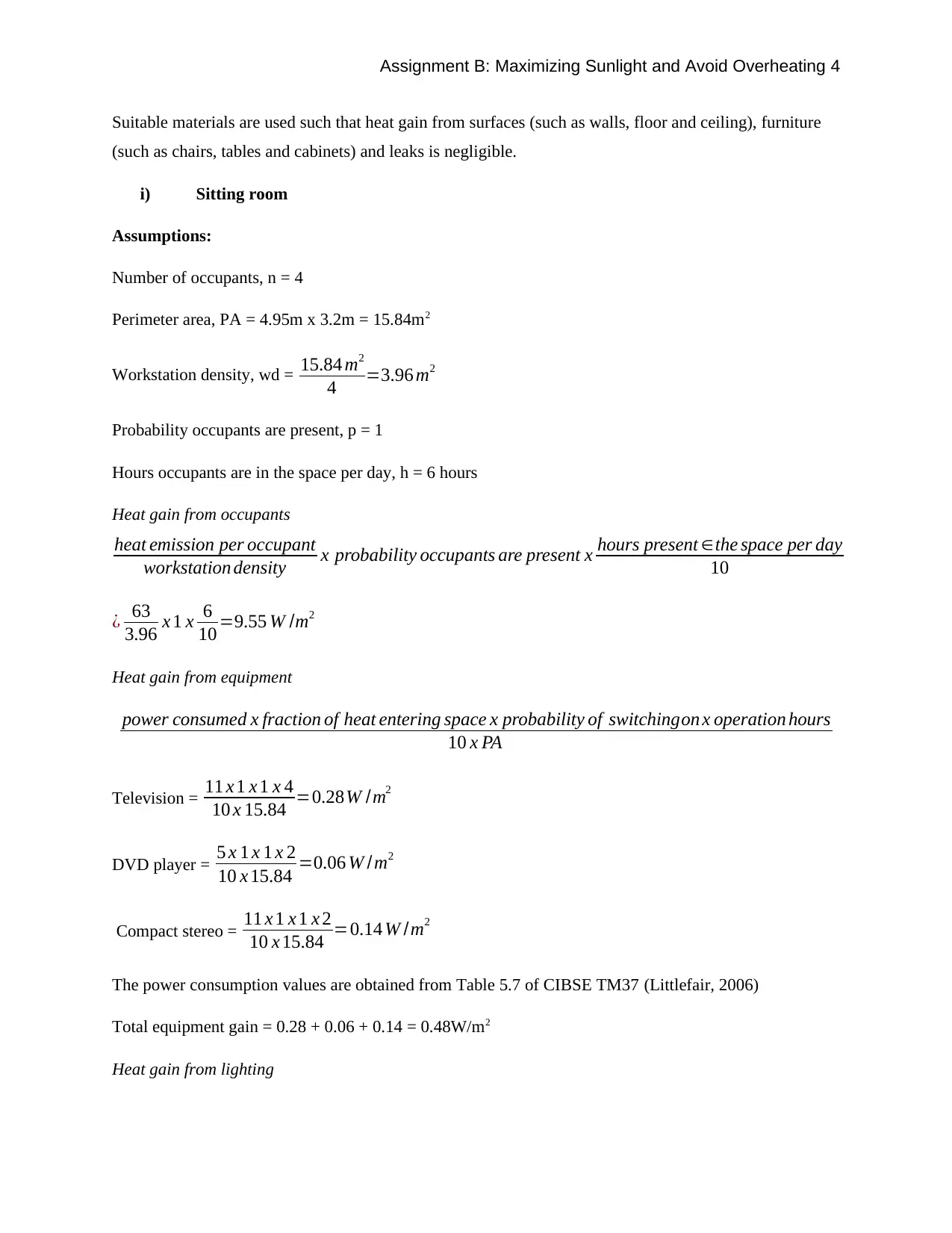
Assignment B: Maximizing Sunlight and Avoid Overheating 4
Suitable materials are used such that heat gain from surfaces (such as walls, floor and ceiling), furniture
(such as chairs, tables and cabinets) and leaks is negligible.
i) Sitting room
Assumptions:
Number of occupants, n = 4
Perimeter area, PA = 4.95m x 3.2m = 15.84m2
Workstation density, wd = 15.84 m2
4 =3.96 m2
Probability occupants are present, p = 1
Hours occupants are in the space per day, h = 6 hours
Heat gain from occupants
heat emission per occupant
workstation density x probability occupants are present x hours present ∈the space per day
10
¿ 63
3.96 x 1 x 6
10 =9.55 W /m2
Heat gain from equipment
power consumed x fraction of heat entering space x probability of switchingon x operation hours
10 x PA
Television = 11 x 1 x 1 x 4
10 x 15.84 =0.28W /m2
DVD player = 5 x 1 x 1 x 2
10 x 15.84 =0.06 W /m2
Compact stereo = 11 x 1 x 1 x 2
10 x 15.84 =0.14 W /m2
The power consumption values are obtained from Table 5.7 of CIBSE TM37 (Littlefair, 2006)
Total equipment gain = 0.28 + 0.06 + 0.14 = 0.48W/m2
Heat gain from lighting
Suitable materials are used such that heat gain from surfaces (such as walls, floor and ceiling), furniture
(such as chairs, tables and cabinets) and leaks is negligible.
i) Sitting room
Assumptions:
Number of occupants, n = 4
Perimeter area, PA = 4.95m x 3.2m = 15.84m2
Workstation density, wd = 15.84 m2
4 =3.96 m2
Probability occupants are present, p = 1
Hours occupants are in the space per day, h = 6 hours
Heat gain from occupants
heat emission per occupant
workstation density x probability occupants are present x hours present ∈the space per day
10
¿ 63
3.96 x 1 x 6
10 =9.55 W /m2
Heat gain from equipment
power consumed x fraction of heat entering space x probability of switchingon x operation hours
10 x PA
Television = 11 x 1 x 1 x 4
10 x 15.84 =0.28W /m2
DVD player = 5 x 1 x 1 x 2
10 x 15.84 =0.06 W /m2
Compact stereo = 11 x 1 x 1 x 2
10 x 15.84 =0.14 W /m2
The power consumption values are obtained from Table 5.7 of CIBSE TM37 (Littlefair, 2006)
Total equipment gain = 0.28 + 0.06 + 0.14 = 0.48W/m2
Heat gain from lighting
Paraphrase This Document
Need a fresh take? Get an instant paraphrase of this document with our AI Paraphraser
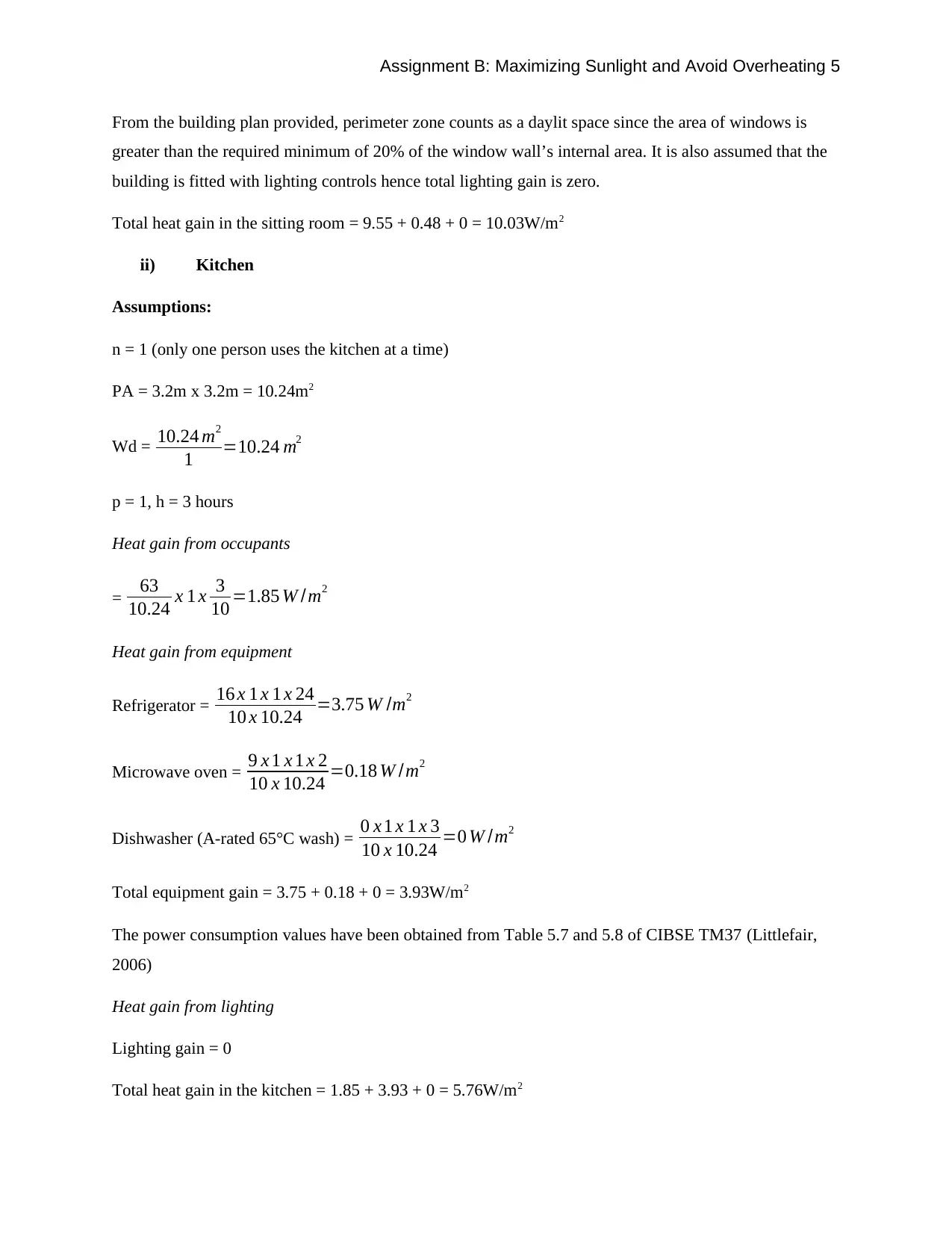
Assignment B: Maximizing Sunlight and Avoid Overheating 5
From the building plan provided, perimeter zone counts as a daylit space since the area of windows is
greater than the required minimum of 20% of the window wall’s internal area. It is also assumed that the
building is fitted with lighting controls hence total lighting gain is zero.
Total heat gain in the sitting room = 9.55 + 0.48 + 0 = 10.03W/m2
ii) Kitchen
Assumptions:
n = 1 (only one person uses the kitchen at a time)
PA = 3.2m x 3.2m = 10.24m2
Wd = 10.24 m2
1 =10.24 m2
p = 1, h = 3 hours
Heat gain from occupants
= 63
10.24 x 1 x 3
10 =1.85 W /m2
Heat gain from equipment
Refrigerator = 16 x 1 x 1 x 24
10 x 10.24 =3.75 W /m2
Microwave oven = 9 x 1 x 1 x 2
10 x 10.24 =0.18 W /m2
Dishwasher (A-rated 65°C wash) = 0 x 1 x 1 x 3
10 x 10.24 =0 W /m2
Total equipment gain = 3.75 + 0.18 + 0 = 3.93W/m2
The power consumption values have been obtained from Table 5.7 and 5.8 of CIBSE TM37 (Littlefair,
2006)
Heat gain from lighting
Lighting gain = 0
Total heat gain in the kitchen = 1.85 + 3.93 + 0 = 5.76W/m2
From the building plan provided, perimeter zone counts as a daylit space since the area of windows is
greater than the required minimum of 20% of the window wall’s internal area. It is also assumed that the
building is fitted with lighting controls hence total lighting gain is zero.
Total heat gain in the sitting room = 9.55 + 0.48 + 0 = 10.03W/m2
ii) Kitchen
Assumptions:
n = 1 (only one person uses the kitchen at a time)
PA = 3.2m x 3.2m = 10.24m2
Wd = 10.24 m2
1 =10.24 m2
p = 1, h = 3 hours
Heat gain from occupants
= 63
10.24 x 1 x 3
10 =1.85 W /m2
Heat gain from equipment
Refrigerator = 16 x 1 x 1 x 24
10 x 10.24 =3.75 W /m2
Microwave oven = 9 x 1 x 1 x 2
10 x 10.24 =0.18 W /m2
Dishwasher (A-rated 65°C wash) = 0 x 1 x 1 x 3
10 x 10.24 =0 W /m2
Total equipment gain = 3.75 + 0.18 + 0 = 3.93W/m2
The power consumption values have been obtained from Table 5.7 and 5.8 of CIBSE TM37 (Littlefair,
2006)
Heat gain from lighting
Lighting gain = 0
Total heat gain in the kitchen = 1.85 + 3.93 + 0 = 5.76W/m2
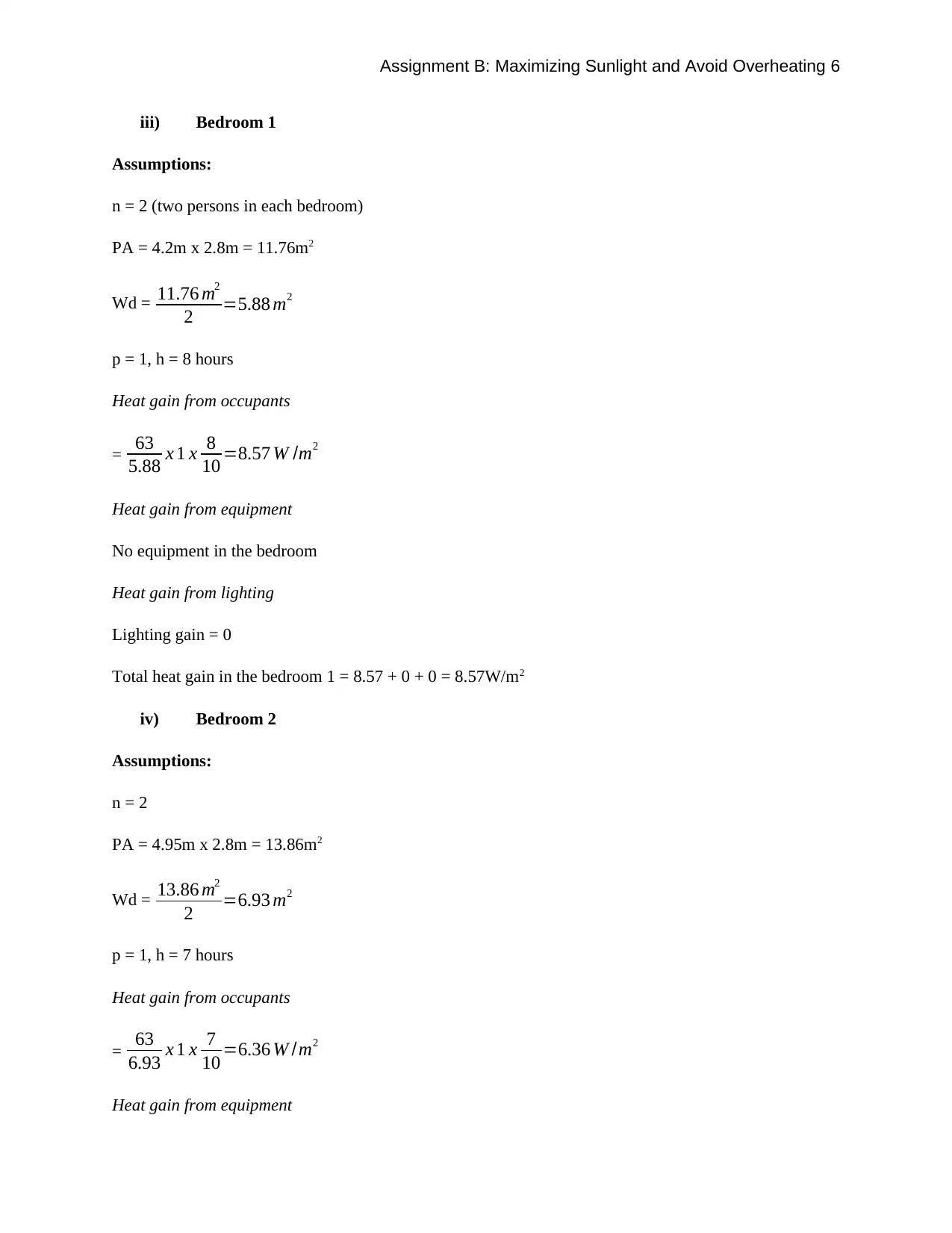
Assignment B: Maximizing Sunlight and Avoid Overheating 6
iii) Bedroom 1
Assumptions:
n = 2 (two persons in each bedroom)
PA = 4.2m x 2.8m = 11.76m2
Wd = 11.76 m2
2 =5.88 m2
p = 1, h = 8 hours
Heat gain from occupants
= 63
5.88 x 1 x 8
10 =8.57 W /m2
Heat gain from equipment
No equipment in the bedroom
Heat gain from lighting
Lighting gain = 0
Total heat gain in the bedroom 1 = 8.57 + 0 + 0 = 8.57W/m2
iv) Bedroom 2
Assumptions:
n = 2
PA = 4.95m x 2.8m = 13.86m2
Wd = 13.86 m2
2 =6.93 m2
p = 1, h = 7 hours
Heat gain from occupants
= 63
6.93 x 1 x 7
10 =6.36 W /m2
Heat gain from equipment
iii) Bedroom 1
Assumptions:
n = 2 (two persons in each bedroom)
PA = 4.2m x 2.8m = 11.76m2
Wd = 11.76 m2
2 =5.88 m2
p = 1, h = 8 hours
Heat gain from occupants
= 63
5.88 x 1 x 8
10 =8.57 W /m2
Heat gain from equipment
No equipment in the bedroom
Heat gain from lighting
Lighting gain = 0
Total heat gain in the bedroom 1 = 8.57 + 0 + 0 = 8.57W/m2
iv) Bedroom 2
Assumptions:
n = 2
PA = 4.95m x 2.8m = 13.86m2
Wd = 13.86 m2
2 =6.93 m2
p = 1, h = 7 hours
Heat gain from occupants
= 63
6.93 x 1 x 7
10 =6.36 W /m2
Heat gain from equipment
⊘ This is a preview!⊘
Do you want full access?
Subscribe today to unlock all pages.

Trusted by 1+ million students worldwide
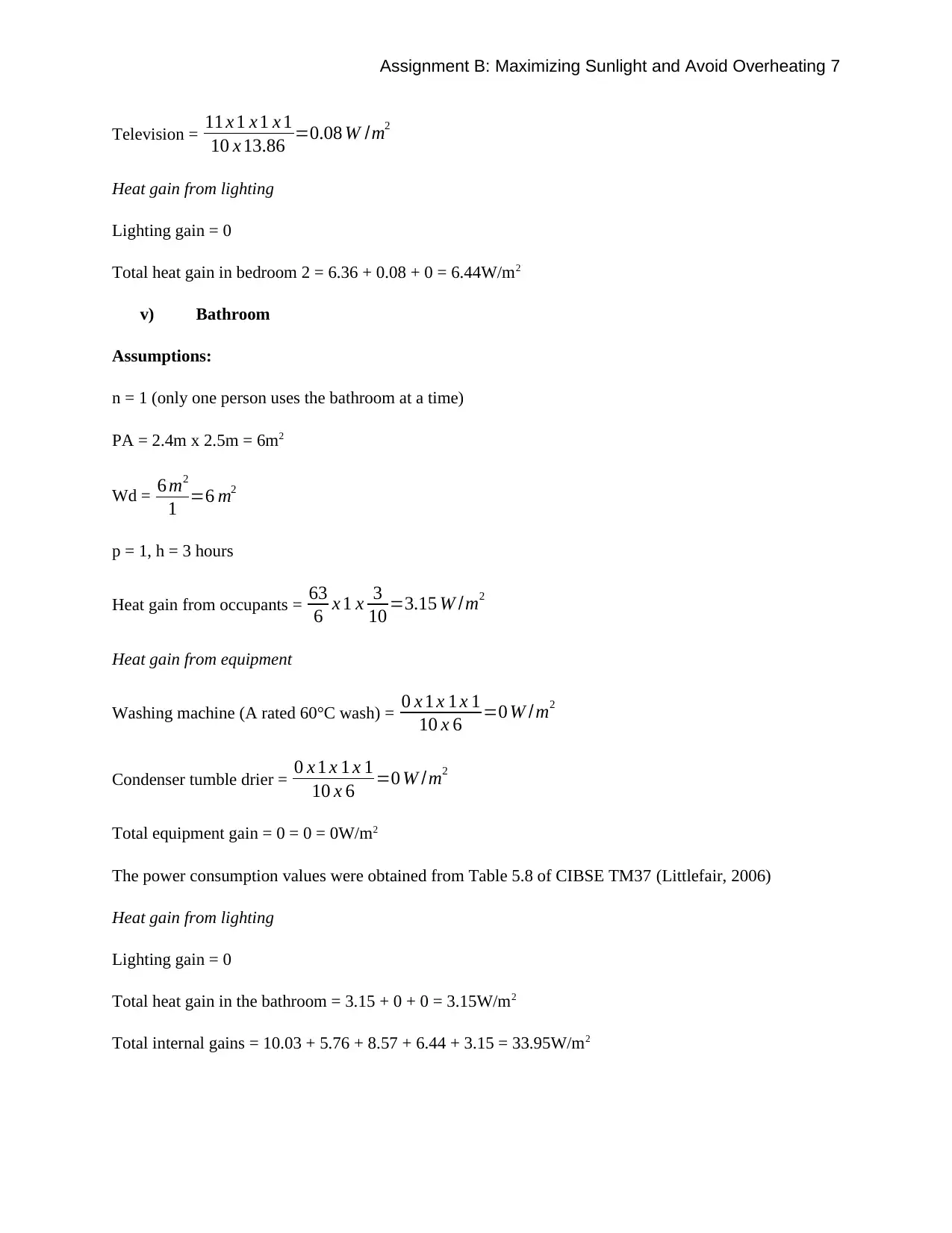
Assignment B: Maximizing Sunlight and Avoid Overheating 7
Television = 11 x 1 x 1 x 1
10 x 13.86 =0.08 W /m2
Heat gain from lighting
Lighting gain = 0
Total heat gain in bedroom 2 = 6.36 + 0.08 + 0 = 6.44W/m2
v) Bathroom
Assumptions:
n = 1 (only one person uses the bathroom at a time)
PA = 2.4m x 2.5m = 6m2
Wd = 6 m2
1 =6 m2
p = 1, h = 3 hours
Heat gain from occupants = 63
6 x 1 x 3
10 =3.15 W /m2
Heat gain from equipment
Washing machine (A rated 60°C wash) = 0 x 1 x 1 x 1
10 x 6 =0 W /m2
Condenser tumble drier = 0 x 1 x 1 x 1
10 x 6 =0 W /m2
Total equipment gain = 0 = 0 = 0W/m2
The power consumption values were obtained from Table 5.8 of CIBSE TM37 (Littlefair, 2006)
Heat gain from lighting
Lighting gain = 0
Total heat gain in the bathroom = 3.15 + 0 + 0 = 3.15W/m2
Total internal gains = 10.03 + 5.76 + 8.57 + 6.44 + 3.15 = 33.95W/m2
Television = 11 x 1 x 1 x 1
10 x 13.86 =0.08 W /m2
Heat gain from lighting
Lighting gain = 0
Total heat gain in bedroom 2 = 6.36 + 0.08 + 0 = 6.44W/m2
v) Bathroom
Assumptions:
n = 1 (only one person uses the bathroom at a time)
PA = 2.4m x 2.5m = 6m2
Wd = 6 m2
1 =6 m2
p = 1, h = 3 hours
Heat gain from occupants = 63
6 x 1 x 3
10 =3.15 W /m2
Heat gain from equipment
Washing machine (A rated 60°C wash) = 0 x 1 x 1 x 1
10 x 6 =0 W /m2
Condenser tumble drier = 0 x 1 x 1 x 1
10 x 6 =0 W /m2
Total equipment gain = 0 = 0 = 0W/m2
The power consumption values were obtained from Table 5.8 of CIBSE TM37 (Littlefair, 2006)
Heat gain from lighting
Lighting gain = 0
Total heat gain in the bathroom = 3.15 + 0 + 0 = 3.15W/m2
Total internal gains = 10.03 + 5.76 + 8.57 + 6.44 + 3.15 = 33.95W/m2
Paraphrase This Document
Need a fresh take? Get an instant paraphrase of this document with our AI Paraphraser
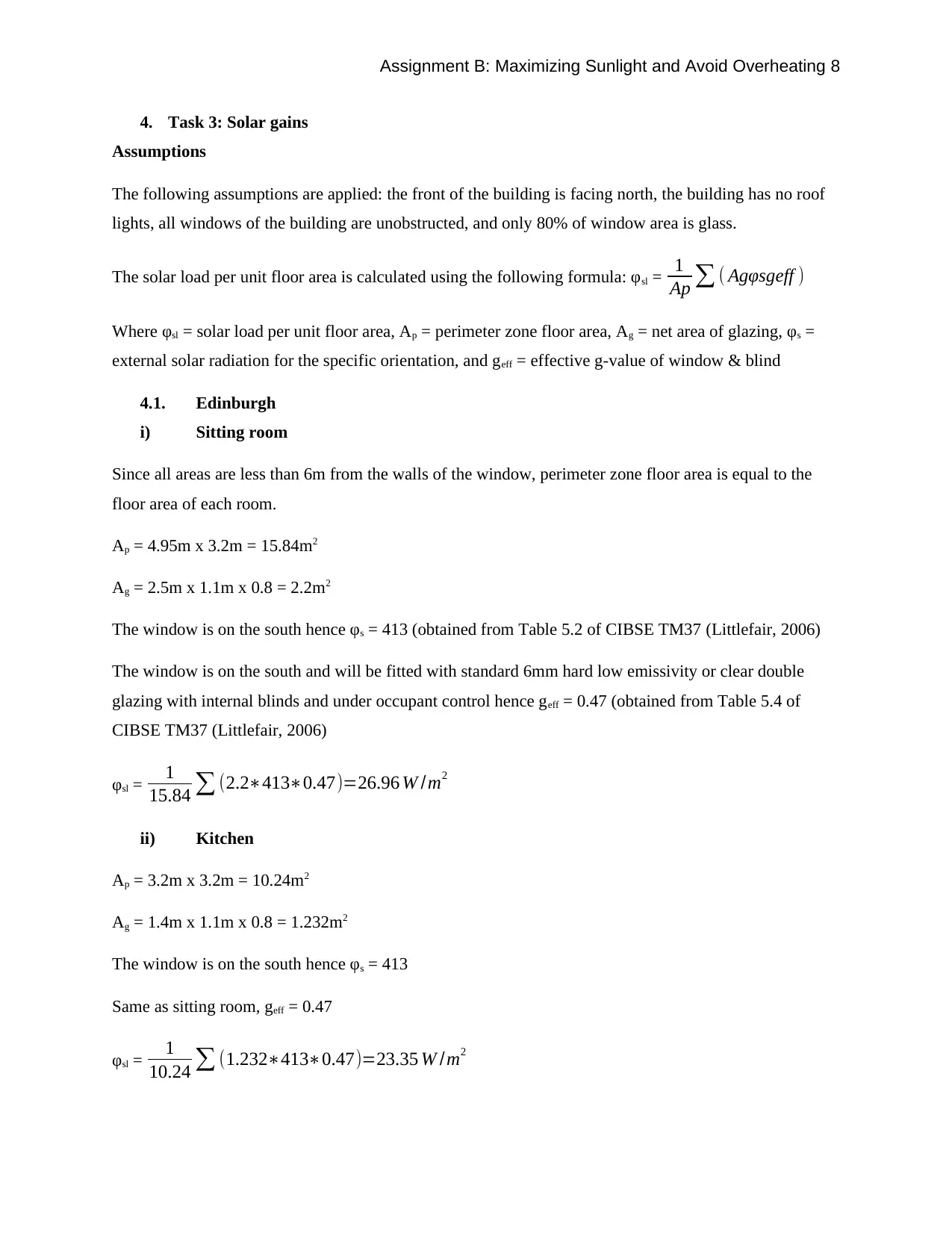
Assignment B: Maximizing Sunlight and Avoid Overheating 8
4. Task 3: Solar gains
Assumptions
The following assumptions are applied: the front of the building is facing north, the building has no roof
lights, all windows of the building are unobstructed, and only 80% of window area is glass.
The solar load per unit floor area is calculated using the following formula: φsl = 1
Ap ∑ ( Agφsgeff )
Where φsl = solar load per unit floor area, Ap = perimeter zone floor area, Ag = net area of glazing, φs =
external solar radiation for the specific orientation, and geff = effective g-value of window & blind
4.1. Edinburgh
i) Sitting room
Since all areas are less than 6m from the walls of the window, perimeter zone floor area is equal to the
floor area of each room.
Ap = 4.95m x 3.2m = 15.84m2
Ag = 2.5m x 1.1m x 0.8 = 2.2m2
The window is on the south hence φs = 413 (obtained from Table 5.2 of CIBSE TM37 (Littlefair, 2006)
The window is on the south and will be fitted with standard 6mm hard low emissivity or clear double
glazing with internal blinds and under occupant control hence geff = 0.47 (obtained from Table 5.4 of
CIBSE TM37 (Littlefair, 2006)
φsl = 1
15.84 ∑ (2.2∗413∗0.47)=26.96 W /m2
ii) Kitchen
Ap = 3.2m x 3.2m = 10.24m2
Ag = 1.4m x 1.1m x 0.8 = 1.232m2
The window is on the south hence φs = 413
Same as sitting room, geff = 0.47
φsl = 1
10.24 ∑ (1.232∗413∗0.47)=23.35 W /m2
4. Task 3: Solar gains
Assumptions
The following assumptions are applied: the front of the building is facing north, the building has no roof
lights, all windows of the building are unobstructed, and only 80% of window area is glass.
The solar load per unit floor area is calculated using the following formula: φsl = 1
Ap ∑ ( Agφsgeff )
Where φsl = solar load per unit floor area, Ap = perimeter zone floor area, Ag = net area of glazing, φs =
external solar radiation for the specific orientation, and geff = effective g-value of window & blind
4.1. Edinburgh
i) Sitting room
Since all areas are less than 6m from the walls of the window, perimeter zone floor area is equal to the
floor area of each room.
Ap = 4.95m x 3.2m = 15.84m2
Ag = 2.5m x 1.1m x 0.8 = 2.2m2
The window is on the south hence φs = 413 (obtained from Table 5.2 of CIBSE TM37 (Littlefair, 2006)
The window is on the south and will be fitted with standard 6mm hard low emissivity or clear double
glazing with internal blinds and under occupant control hence geff = 0.47 (obtained from Table 5.4 of
CIBSE TM37 (Littlefair, 2006)
φsl = 1
15.84 ∑ (2.2∗413∗0.47)=26.96 W /m2
ii) Kitchen
Ap = 3.2m x 3.2m = 10.24m2
Ag = 1.4m x 1.1m x 0.8 = 1.232m2
The window is on the south hence φs = 413
Same as sitting room, geff = 0.47
φsl = 1
10.24 ∑ (1.232∗413∗0.47)=23.35 W /m2
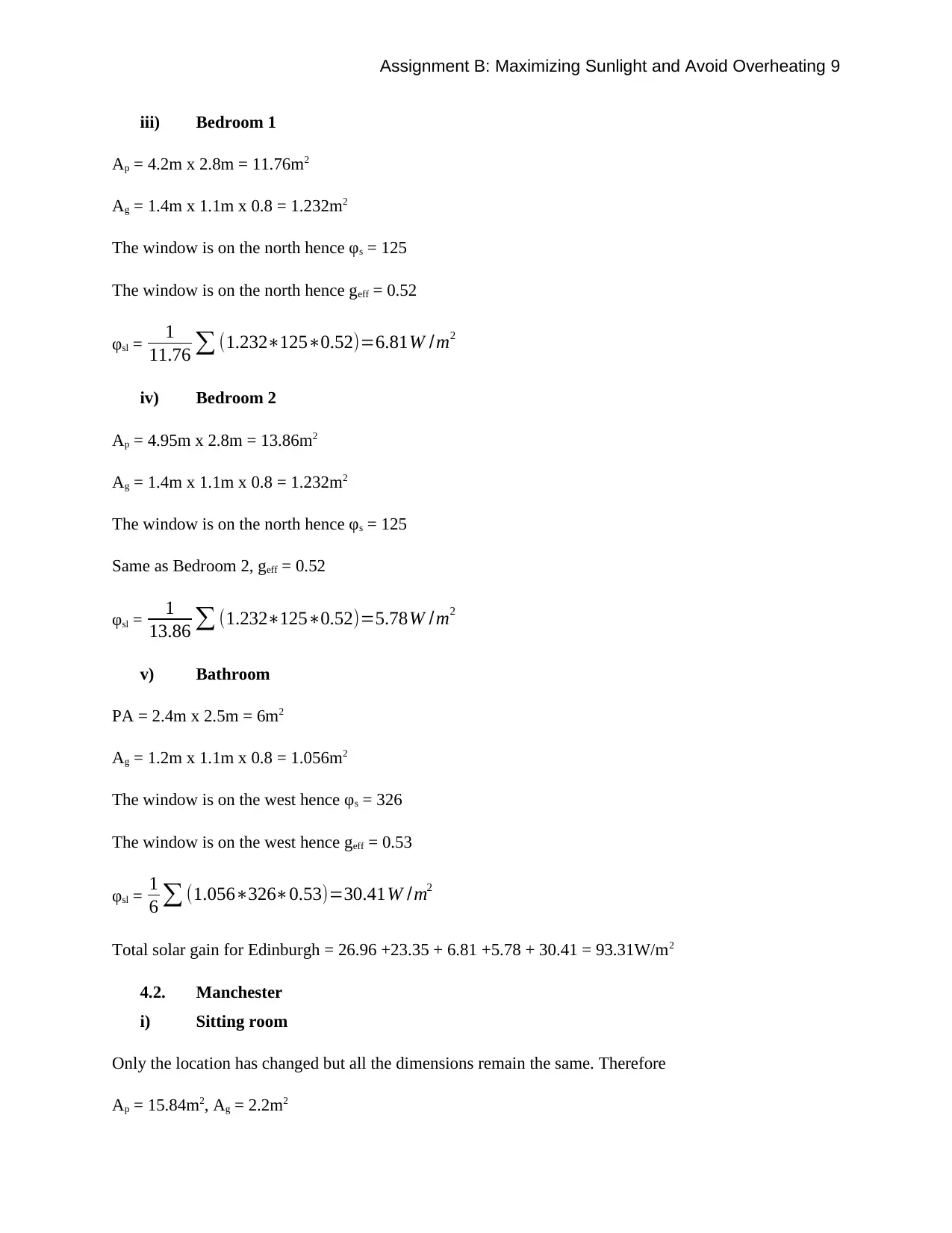
Assignment B: Maximizing Sunlight and Avoid Overheating 9
iii) Bedroom 1
Ap = 4.2m x 2.8m = 11.76m2
Ag = 1.4m x 1.1m x 0.8 = 1.232m2
The window is on the north hence φs = 125
The window is on the north hence geff = 0.52
φsl = 1
11.76 ∑ (1.232∗125∗0.52)=6.81W /m2
iv) Bedroom 2
Ap = 4.95m x 2.8m = 13.86m2
Ag = 1.4m x 1.1m x 0.8 = 1.232m2
The window is on the north hence φs = 125
Same as Bedroom 2, geff = 0.52
φsl = 1
13.86 ∑ (1.232∗125∗0.52)=5.78W /m2
v) Bathroom
PA = 2.4m x 2.5m = 6m2
Ag = 1.2m x 1.1m x 0.8 = 1.056m2
The window is on the west hence φs = 326
The window is on the west hence geff = 0.53
φsl = 1
6 ∑ (1.056∗326∗0.53)=30.41W /m2
Total solar gain for Edinburgh = 26.96 +23.35 + 6.81 +5.78 + 30.41 = 93.31W/m2
4.2. Manchester
i) Sitting room
Only the location has changed but all the dimensions remain the same. Therefore
Ap = 15.84m2, Ag = 2.2m2
iii) Bedroom 1
Ap = 4.2m x 2.8m = 11.76m2
Ag = 1.4m x 1.1m x 0.8 = 1.232m2
The window is on the north hence φs = 125
The window is on the north hence geff = 0.52
φsl = 1
11.76 ∑ (1.232∗125∗0.52)=6.81W /m2
iv) Bedroom 2
Ap = 4.95m x 2.8m = 13.86m2
Ag = 1.4m x 1.1m x 0.8 = 1.232m2
The window is on the north hence φs = 125
Same as Bedroom 2, geff = 0.52
φsl = 1
13.86 ∑ (1.232∗125∗0.52)=5.78W /m2
v) Bathroom
PA = 2.4m x 2.5m = 6m2
Ag = 1.2m x 1.1m x 0.8 = 1.056m2
The window is on the west hence φs = 326
The window is on the west hence geff = 0.53
φsl = 1
6 ∑ (1.056∗326∗0.53)=30.41W /m2
Total solar gain for Edinburgh = 26.96 +23.35 + 6.81 +5.78 + 30.41 = 93.31W/m2
4.2. Manchester
i) Sitting room
Only the location has changed but all the dimensions remain the same. Therefore
Ap = 15.84m2, Ag = 2.2m2
⊘ This is a preview!⊘
Do you want full access?
Subscribe today to unlock all pages.

Trusted by 1+ million students worldwide
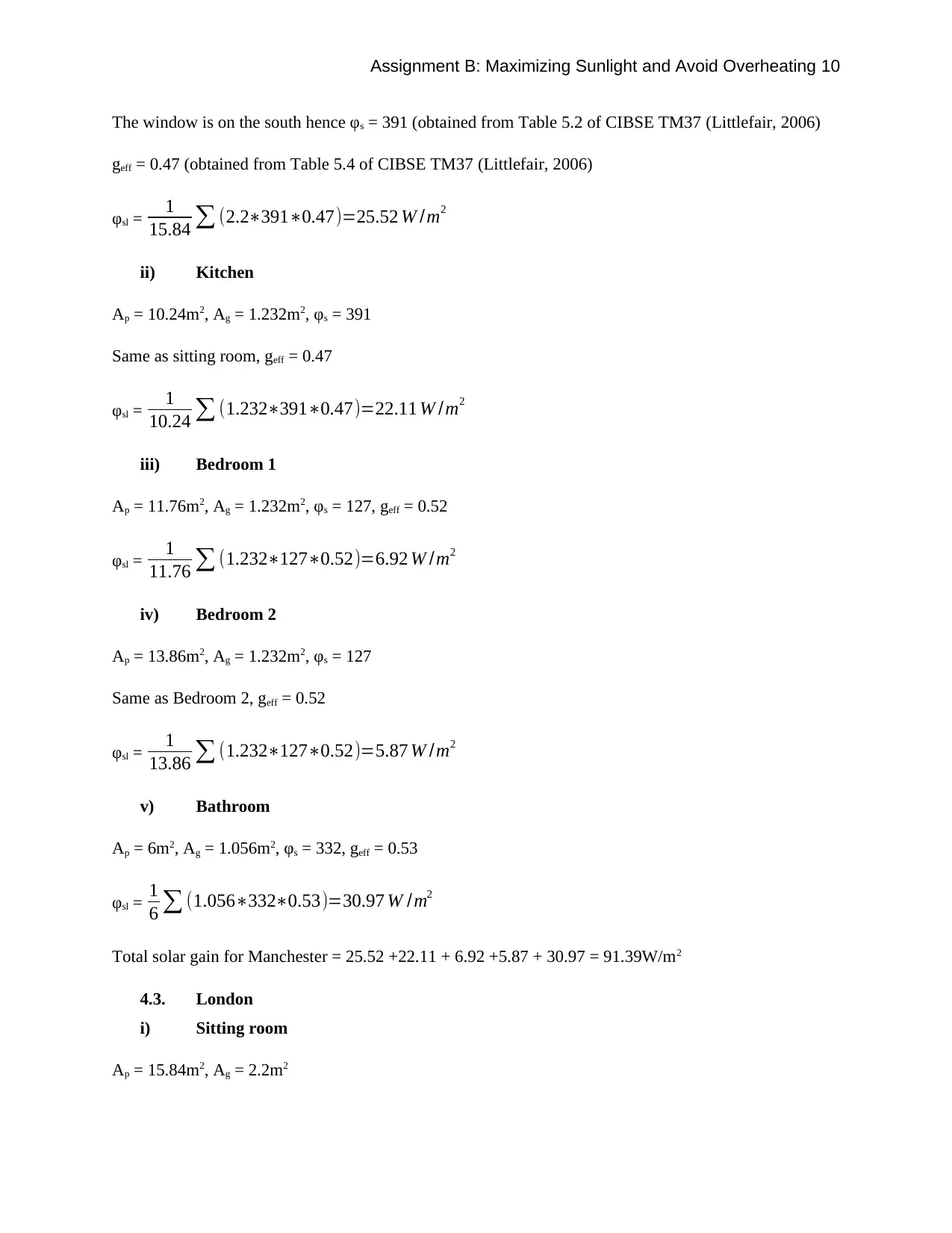
Assignment B: Maximizing Sunlight and Avoid Overheating 10
The window is on the south hence φs = 391 (obtained from Table 5.2 of CIBSE TM37 (Littlefair, 2006)
geff = 0.47 (obtained from Table 5.4 of CIBSE TM37 (Littlefair, 2006)
φsl = 1
15.84 ∑ (2.2∗391∗0.47)=25.52 W /m2
ii) Kitchen
Ap = 10.24m2, Ag = 1.232m2, φs = 391
Same as sitting room, geff = 0.47
φsl = 1
10.24 ∑ (1.232∗391∗0.47)=22.11 W /m2
iii) Bedroom 1
Ap = 11.76m2, Ag = 1.232m2, φs = 127, geff = 0.52
φsl = 1
11.76 ∑ (1.232∗127∗0.52)=6.92 W /m2
iv) Bedroom 2
Ap = 13.86m2, Ag = 1.232m2, φs = 127
Same as Bedroom 2, geff = 0.52
φsl = 1
13.86 ∑ (1.232∗127∗0.52)=5.87 W /m2
v) Bathroom
Ap = 6m2, Ag = 1.056m2, φs = 332, geff = 0.53
φsl = 1
6 ∑ (1.056∗332∗0.53)=30.97 W /m2
Total solar gain for Manchester = 25.52 +22.11 + 6.92 +5.87 + 30.97 = 91.39W/m2
4.3. London
i) Sitting room
Ap = 15.84m2, Ag = 2.2m2
The window is on the south hence φs = 391 (obtained from Table 5.2 of CIBSE TM37 (Littlefair, 2006)
geff = 0.47 (obtained from Table 5.4 of CIBSE TM37 (Littlefair, 2006)
φsl = 1
15.84 ∑ (2.2∗391∗0.47)=25.52 W /m2
ii) Kitchen
Ap = 10.24m2, Ag = 1.232m2, φs = 391
Same as sitting room, geff = 0.47
φsl = 1
10.24 ∑ (1.232∗391∗0.47)=22.11 W /m2
iii) Bedroom 1
Ap = 11.76m2, Ag = 1.232m2, φs = 127, geff = 0.52
φsl = 1
11.76 ∑ (1.232∗127∗0.52)=6.92 W /m2
iv) Bedroom 2
Ap = 13.86m2, Ag = 1.232m2, φs = 127
Same as Bedroom 2, geff = 0.52
φsl = 1
13.86 ∑ (1.232∗127∗0.52)=5.87 W /m2
v) Bathroom
Ap = 6m2, Ag = 1.056m2, φs = 332, geff = 0.53
φsl = 1
6 ∑ (1.056∗332∗0.53)=30.97 W /m2
Total solar gain for Manchester = 25.52 +22.11 + 6.92 +5.87 + 30.97 = 91.39W/m2
4.3. London
i) Sitting room
Ap = 15.84m2, Ag = 2.2m2
Paraphrase This Document
Need a fresh take? Get an instant paraphrase of this document with our AI Paraphraser
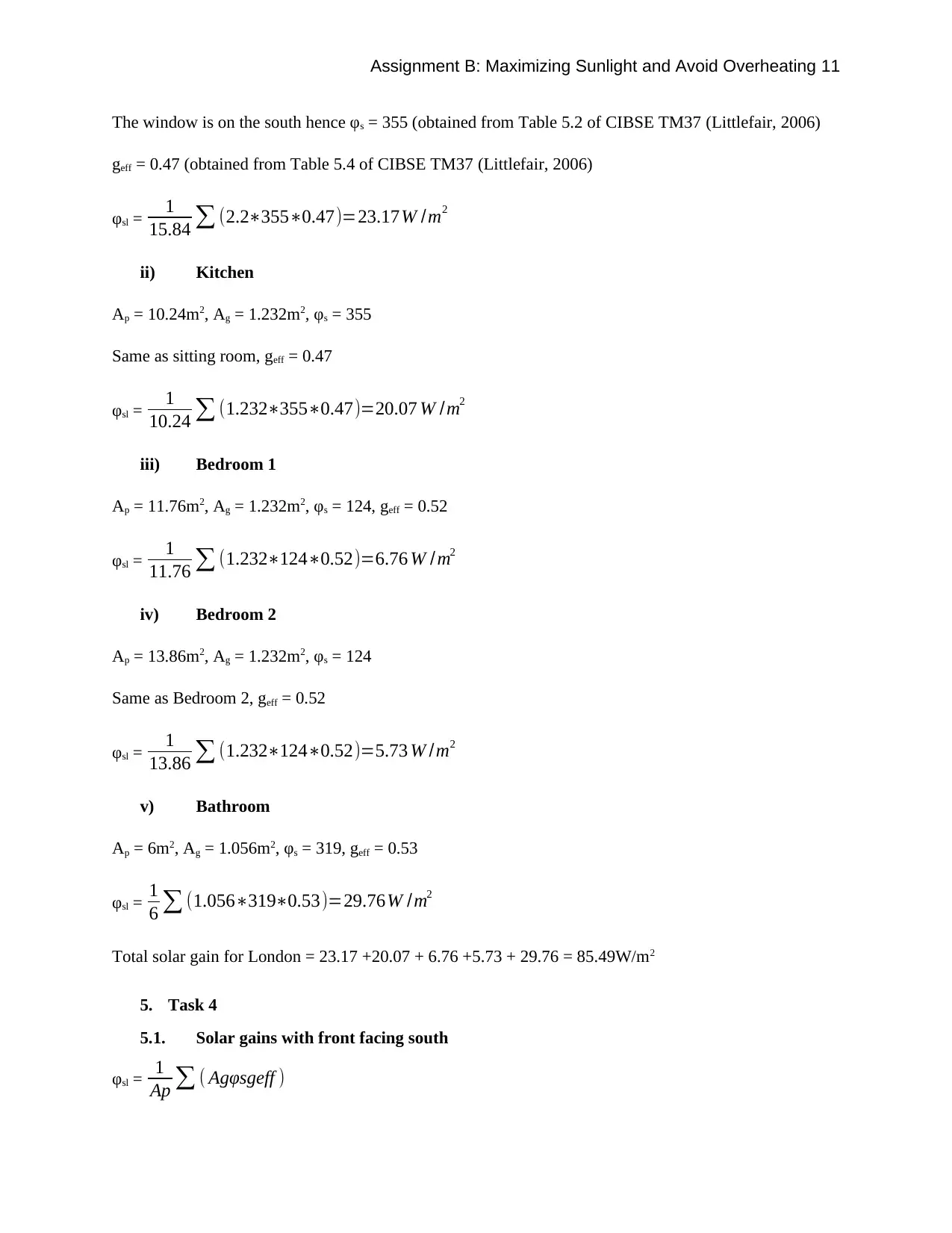
Assignment B: Maximizing Sunlight and Avoid Overheating 11
The window is on the south hence φs = 355 (obtained from Table 5.2 of CIBSE TM37 (Littlefair, 2006)
geff = 0.47 (obtained from Table 5.4 of CIBSE TM37 (Littlefair, 2006)
φsl = 1
15.84 ∑ (2.2∗355∗0.47)=23.17W /m2
ii) Kitchen
Ap = 10.24m2, Ag = 1.232m2, φs = 355
Same as sitting room, geff = 0.47
φsl = 1
10.24 ∑ (1.232∗355∗0.47)=20.07 W /m2
iii) Bedroom 1
Ap = 11.76m2, Ag = 1.232m2, φs = 124, geff = 0.52
φsl = 1
11.76 ∑ (1.232∗124∗0.52)=6.76 W / m2
iv) Bedroom 2
Ap = 13.86m2, Ag = 1.232m2, φs = 124
Same as Bedroom 2, geff = 0.52
φsl = 1
13.86 ∑ (1.232∗124∗0.52)=5.73 W /m2
v) Bathroom
Ap = 6m2, Ag = 1.056m2, φs = 319, geff = 0.53
φsl = 1
6 ∑ (1.056∗319∗0.53)=29.76W /m2
Total solar gain for London = 23.17 +20.07 + 6.76 +5.73 + 29.76 = 85.49W/m2
5. Task 4
5.1. Solar gains with front facing south
φsl = 1
Ap ∑ ( Agφsgeff )
The window is on the south hence φs = 355 (obtained from Table 5.2 of CIBSE TM37 (Littlefair, 2006)
geff = 0.47 (obtained from Table 5.4 of CIBSE TM37 (Littlefair, 2006)
φsl = 1
15.84 ∑ (2.2∗355∗0.47)=23.17W /m2
ii) Kitchen
Ap = 10.24m2, Ag = 1.232m2, φs = 355
Same as sitting room, geff = 0.47
φsl = 1
10.24 ∑ (1.232∗355∗0.47)=20.07 W /m2
iii) Bedroom 1
Ap = 11.76m2, Ag = 1.232m2, φs = 124, geff = 0.52
φsl = 1
11.76 ∑ (1.232∗124∗0.52)=6.76 W / m2
iv) Bedroom 2
Ap = 13.86m2, Ag = 1.232m2, φs = 124
Same as Bedroom 2, geff = 0.52
φsl = 1
13.86 ∑ (1.232∗124∗0.52)=5.73 W /m2
v) Bathroom
Ap = 6m2, Ag = 1.056m2, φs = 319, geff = 0.53
φsl = 1
6 ∑ (1.056∗319∗0.53)=29.76W /m2
Total solar gain for London = 23.17 +20.07 + 6.76 +5.73 + 29.76 = 85.49W/m2
5. Task 4
5.1. Solar gains with front facing south
φsl = 1
Ap ∑ ( Agφsgeff )
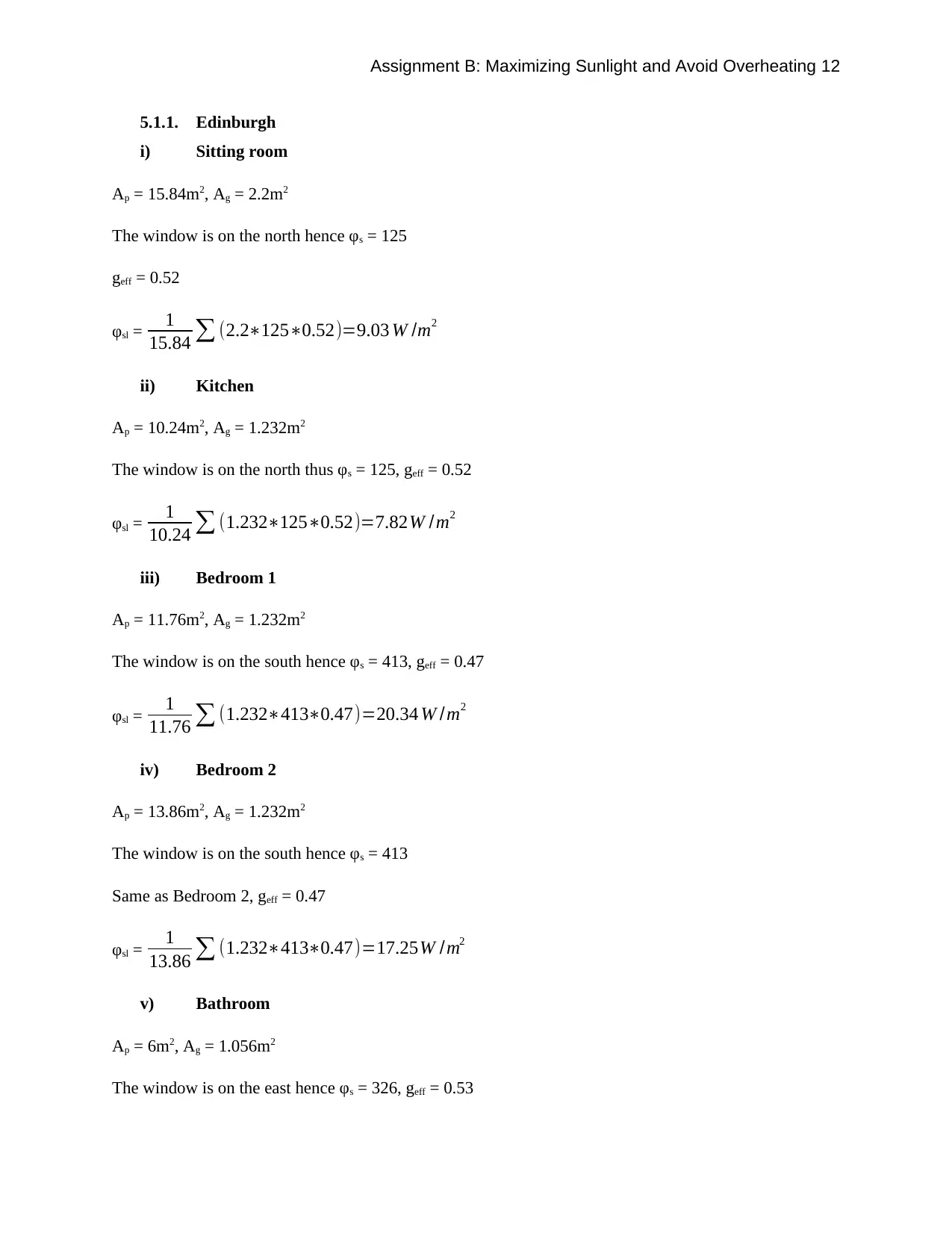
Assignment B: Maximizing Sunlight and Avoid Overheating 12
5.1.1. Edinburgh
i) Sitting room
Ap = 15.84m2, Ag = 2.2m2
The window is on the north hence φs = 125
geff = 0.52
φsl = 1
15.84 ∑ (2.2∗125∗0.52)=9.03 W /m2
ii) Kitchen
Ap = 10.24m2, Ag = 1.232m2
The window is on the north thus φs = 125, geff = 0.52
φsl = 1
10.24 ∑ (1.232∗125∗0.52)=7.82W /m2
iii) Bedroom 1
Ap = 11.76m2, Ag = 1.232m2
The window is on the south hence φs = 413, geff = 0.47
φsl = 1
11.76 ∑ (1.232∗413∗0.47)=20.34 W /m2
iv) Bedroom 2
Ap = 13.86m2, Ag = 1.232m2
The window is on the south hence φs = 413
Same as Bedroom 2, geff = 0.47
φsl = 1
13.86 ∑ (1.232∗413∗0.47)=17.25W /m2
v) Bathroom
Ap = 6m2, Ag = 1.056m2
The window is on the east hence φs = 326, geff = 0.53
5.1.1. Edinburgh
i) Sitting room
Ap = 15.84m2, Ag = 2.2m2
The window is on the north hence φs = 125
geff = 0.52
φsl = 1
15.84 ∑ (2.2∗125∗0.52)=9.03 W /m2
ii) Kitchen
Ap = 10.24m2, Ag = 1.232m2
The window is on the north thus φs = 125, geff = 0.52
φsl = 1
10.24 ∑ (1.232∗125∗0.52)=7.82W /m2
iii) Bedroom 1
Ap = 11.76m2, Ag = 1.232m2
The window is on the south hence φs = 413, geff = 0.47
φsl = 1
11.76 ∑ (1.232∗413∗0.47)=20.34 W /m2
iv) Bedroom 2
Ap = 13.86m2, Ag = 1.232m2
The window is on the south hence φs = 413
Same as Bedroom 2, geff = 0.47
φsl = 1
13.86 ∑ (1.232∗413∗0.47)=17.25W /m2
v) Bathroom
Ap = 6m2, Ag = 1.056m2
The window is on the east hence φs = 326, geff = 0.53
⊘ This is a preview!⊘
Do you want full access?
Subscribe today to unlock all pages.

Trusted by 1+ million students worldwide
1 out of 28
Related Documents
Your All-in-One AI-Powered Toolkit for Academic Success.
+13062052269
info@desklib.com
Available 24*7 on WhatsApp / Email
![[object Object]](/_next/static/media/star-bottom.7253800d.svg)
Unlock your academic potential
Copyright © 2020–2025 A2Z Services. All Rights Reserved. Developed and managed by ZUCOL.





